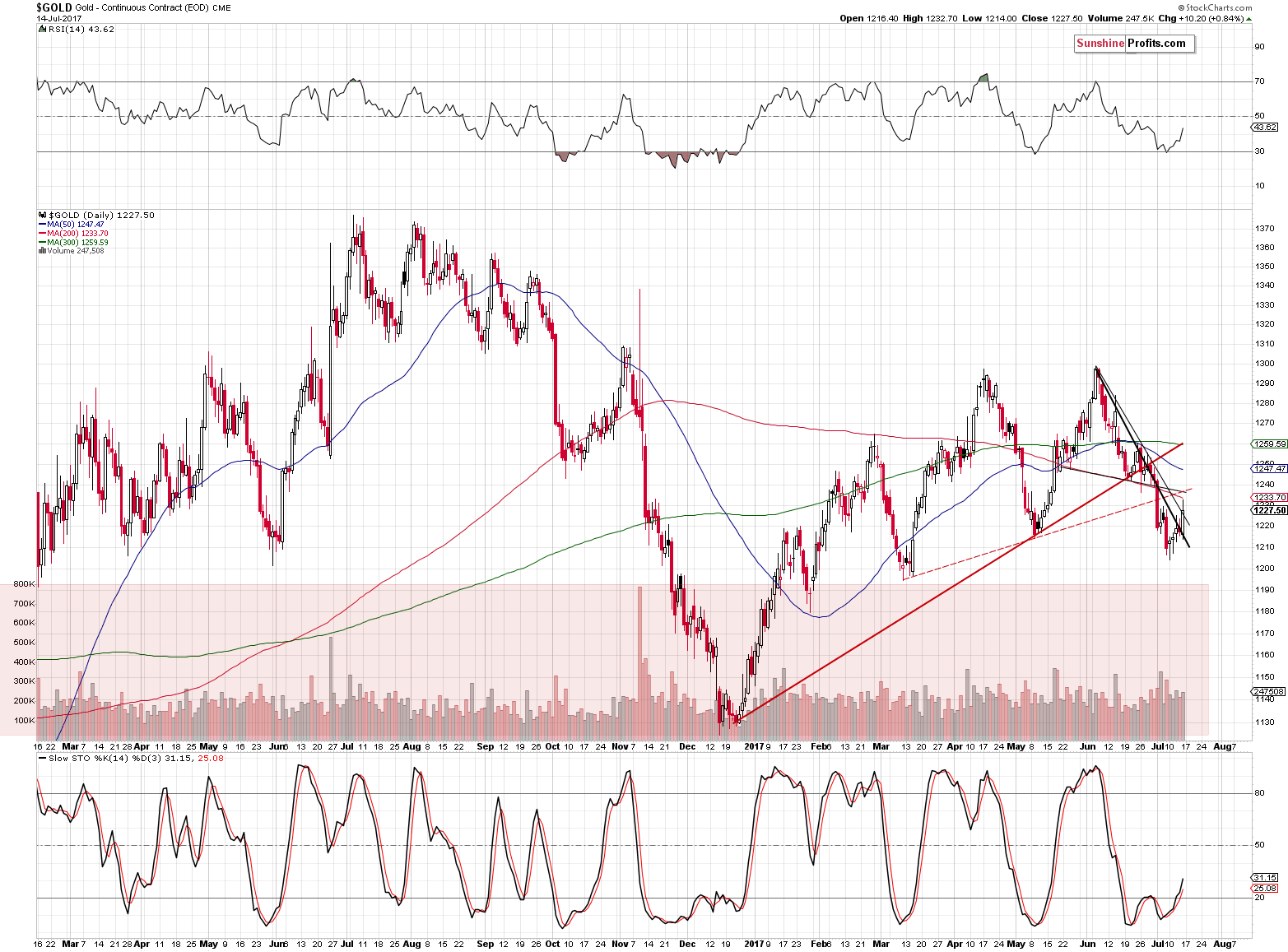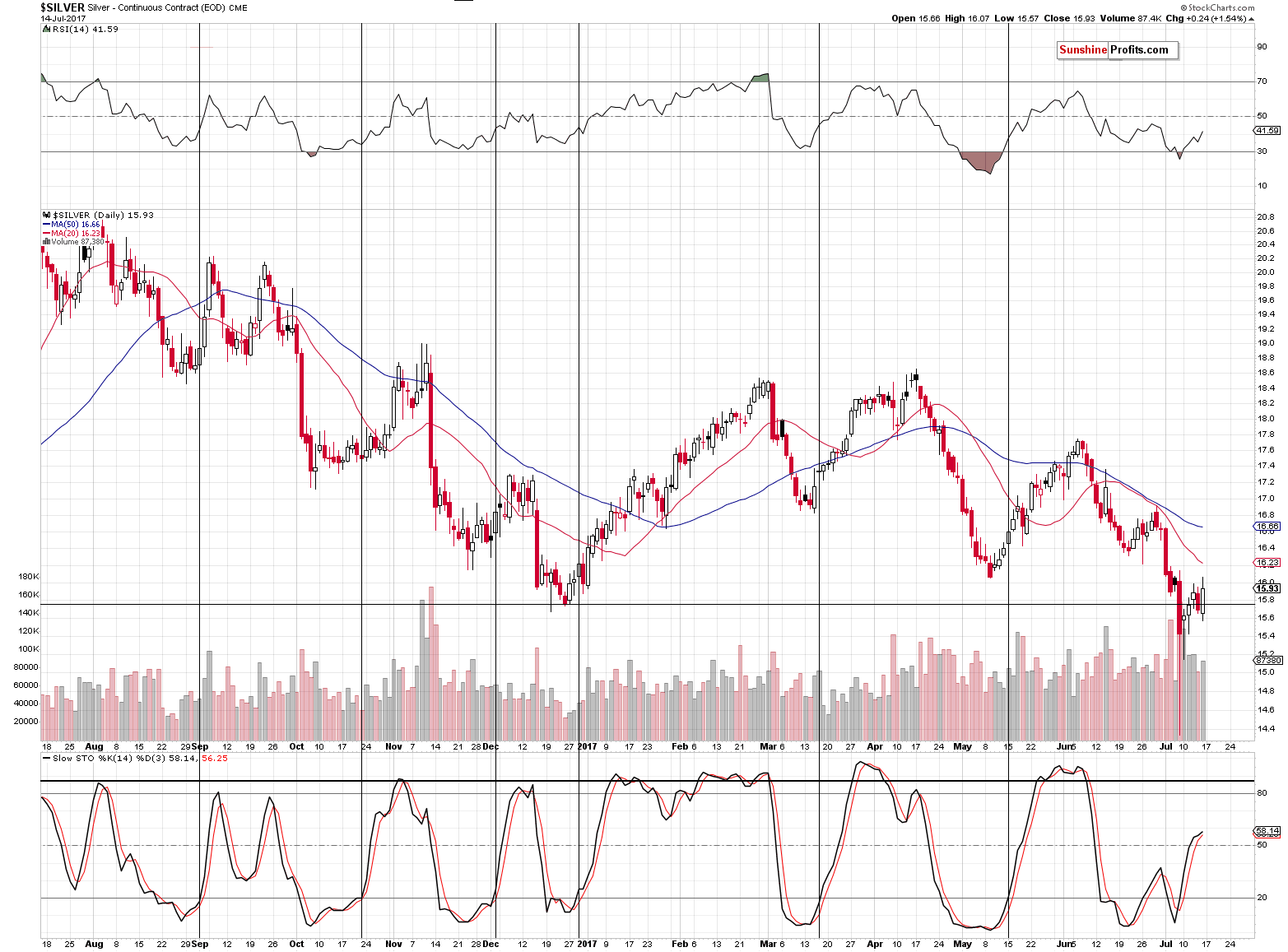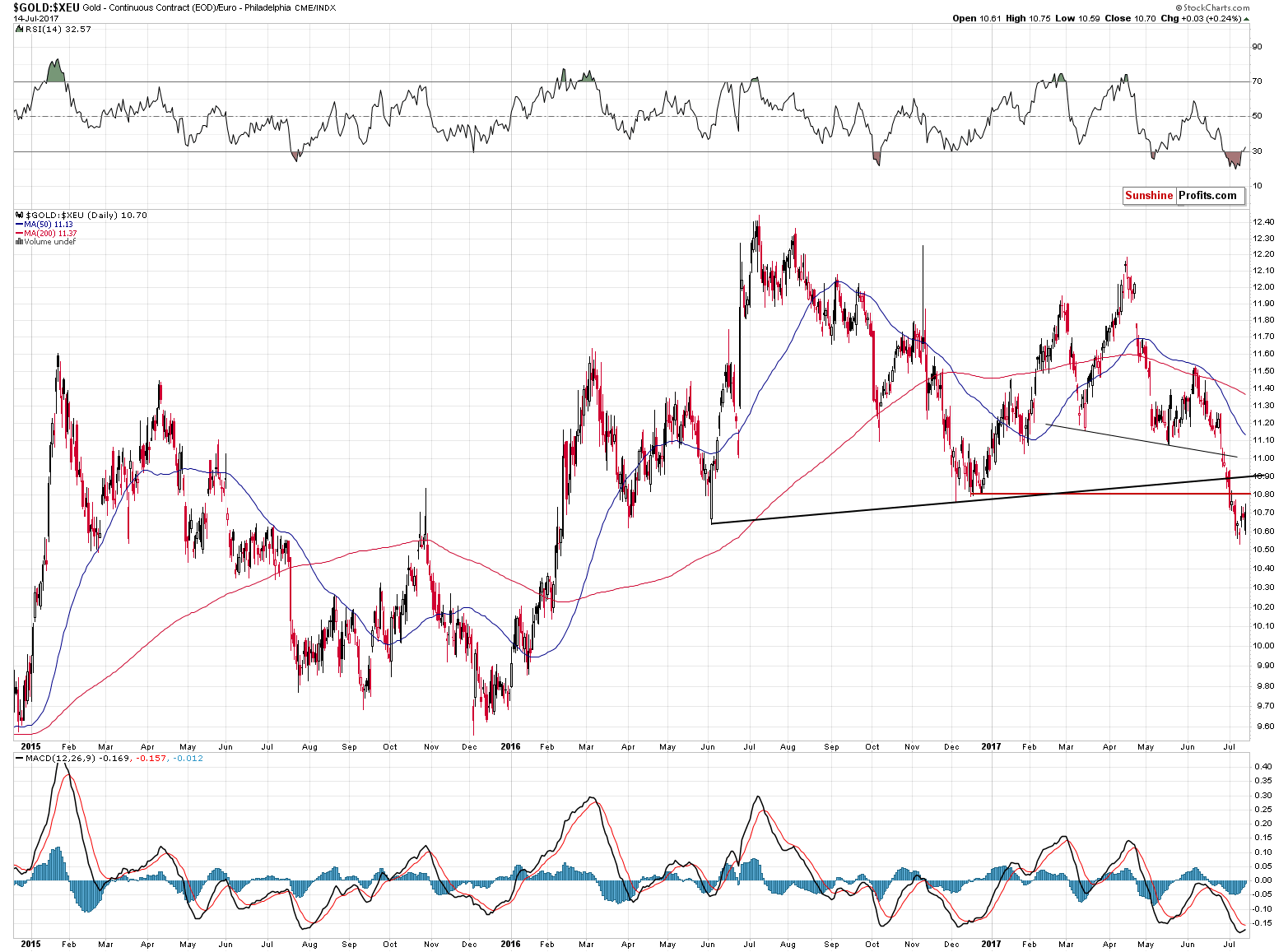Briefly: In our opinion, full (150% of the regular full position) speculative short positions in gold, silver and mining stocks are justified from the risk/reward perspective at the moment of publishing this alert.
Friday’s session was exciting, but this was the case for other reasons than gold’s and silver’s sharp pre-market rally. It was exciting because Friday’s close was also the weekly close and we saw numerous important signs based on it in both important markets and important ratios. Let’s jump right into the charts (chart courtesy of http://stockcharts.com).

Gold closed the week above the declining resistance line based on the previous closing prices and it closed at the one based on the intra-day highs. It also closed below both rising red resistance lines. Did the situation improve on the above chart based on Friday’s close? Yes, but only slightly.

Even smaller improvement is seen on the above silver chart. The white metal moved very briefly above the $16 level and the May 2017 low, but these small breakouts were quickly invalidated. Silver ended the session higher and it was yet another day in the previous week that silver closed above the December 2016 low. Still, since the previous move above it was invalidated on the very next day, it seems that we should wait for the confirmation of this move before implying anything bullish based on it.
Moving back to gold, the weekly close was significant in the case of its price in terms of currencies other than the U.S. dollar.

In the case of gold priced in the euro, we saw the confirmation of breakdowns below important support levels. The head-and-shoulders formation based on the 2016 and 2017 performance appears to be verified and the implications are very bearish for the following weeks.

Gold priced in the Canadian dollar is bearish as well – the breakdown below the rising trend channel is clearly visible and confirmed by a weekly close.

Gold priced in the Australian dollar also provides us with a bearish outlook – the price closed the week well below both important support lines, the rising and the declining ones.

The same goes for the ratio between gold and the broad stock market. Last week’s close was below the lowest weekly close of 2017 and in fact it’s the lowest weekly close that we’ve seen in the past 10 years or so. The breakdown is confirmed and the implications are very bearish for the following weeks and months.
Moving to the mining stocks sector, let’s start with the short-term chart.

Gold stocks moved to the declining red resistance line based on the short-term tops and didn’t break above it. Miners also didn’t break above Wednesday’s high (in terms of daily closing prices), even though gold did break above it in a quite visible way. In other words, the gold stocks’ underperformance is back and since they reached their resistance, the turnaround is likely to be seen shortly.

The above chart confirms that gold stocks are underperforming gold as the ratio is moving lower after touching the declining resistance line. The trend in the ratio is clearly down and the implications for the following weeks are also bearish.

Looking at the weekly price and volume changes in the GDX ETF, we see that for the vast majority of the year and in particular in the recent months, the volume that accompanied weekly upswings was considerably lower than what we saw when miners declined on a weekly basis. That’s a bearish indication for the following weeks and months, especially that last week was also accompanied by relatively low volume.

The Euro Index closed the week very close to the previous highs and consequently a turnaround and major decline appear to be just around the corner. This is confirmed by the RSI indicator – practically in each case when it was at the current levels, a major top formed and the Euro Index declined for months (late 2013 was the only exception, however, please note that the top that the Euro Index had reached at that time was very close to the final 2014 top that was followed by a huge, multi-month slide). The implications are bearish for the Euro Index.

The most important details regarding Friday’s decline remains unchanged – the decline took place exactly at the turning point, which suggests that we will see a reversal very soon – perhaps event today.
The daily RSI indicator also supports a turnaround as its very close to the 30 level, which very often (please note the red arrows on the above chart) corresponded to bottoms. The USD Index also reached the lower border of the declining trend channel. To be precise, it moved a bit below it, but the same thing happened in late June and that proved to be a local bottom anyway and – more importantly – this was enough to start a sizable downswing in gold and silver.

Also, if we draw the same trading channel (and also an additional, short-term one) in the case of the UUP ETF (it’s based on the USD Index) it also confirms that the support lines were just reached.
Combining the above with the situation in the Euro Index, we have a very bullish picture for the U.S. currency, which has very bearish implications for the precious metals market, especially that the latter is no longer able to sustain rallies based on the USD’s declines (please compare the USD’s and gold’s performance since April).
Summing up, there are multiple important bearish signs in play that make the decreased clarity on gold and silver charts rather unimportant. The weekly closing prices confirmed several important breakdowns in gold priced in major currencies as well as in the gold to S&P 500 ratio. As we had already written previously, we could see higher prices in the coming days, but much lower prices in the coming weeks and months. Any strength here is likely to be only temporary.
As always, we will keep you – our subscribers – informed.
To summarize:
Trading capital (supplementary part of the portfolio; our opinion): Short positions (150% of the full position) in gold, silver and mining stocks are justified from the risk/reward perspective with the following stop-loss orders and initial target price levels / profit-take orders:
- Gold: initial target price level: $1,063; stop-loss: $1,317; initial target price for the DGLD ETN: $81.88; stop-loss for the DGLD ETN $44.57
- Silver: initial target price: $13.12; stop-loss: $19.22; initial target price for the DSLV ETN: $46.18; stop-loss for the DSLV ETN $17.93
- Mining stocks (price levels for the GDX ETF): initial target price: $9.34; stop-loss: $26.34; initial target price for the DUST ETF: $143.56; stop-loss for the DUST ETF $21.37
In case one wants to bet on junior mining stocks' prices (we do not suggest doing so – we think senior mining stocks are more predictable in the case of short-term trades – if one wants to do it anyway, we provide the details), here are the stop-loss details and initial target prices:
- GDXJ ETF: initial target price: $14.13; stop-loss: $45.31
- JDST ETF: initial target price: $417.04; stop-loss: $43.12
Long-term capital (core part of the portfolio; our opinion): No positions (in other words: cash)
Insurance capital (core part of the portfolio; our opinion): Full position
Important Details for New Subscribers
Whether you already subscribed or not, we encourage you to find out how to make the most of our alerts and read our replies to the most common alert-and-gold-trading-related-questions.
Please note that the in the trading section we describe the situation for the day that the alert is posted. In other words, it we are writing about a speculative position, it means that it is up-to-date on the day it was posted. We are also featuring the initial target prices, so that you can decide whether keeping a position on a given day is something that is in tune with your approach (some moves are too small for medium-term traders and some might appear too big for day-traders).
Plus, you might want to read why our stop-loss orders are usually relatively far from the current price.
Please note that a full position doesn’t mean using all of the capital for a given trade. You will find details on our thoughts on gold portfolio structuring in the Key Insights section on our website.
As a reminder – “initial target price” means exactly that – an “initial” one, it’s not a price level at which we suggest closing positions. If this becomes the case (like it did in the previous trade) we will refer to these levels as levels of exit orders (exactly as we’ve done previously). Stop-loss levels, however, are naturally not “initial”, but something that, in our opinion, might be entered as an order.
Since it is impossible to synchronize target prices and stop-loss levels for all the ETFs and ETNs with the main markets that we provide these levels for (gold, silver and mining stocks – the GDX ETF), the stop-loss levels and target prices for other ETNs and ETF (among other: UGLD, DGLD, USLV, DSLV, NUGT, DUST, JNUG, JDST) are provided as supplementary, and not as “final”. This means that if a stop-loss or a target level is reached for any of the “additional instruments” (DGLD for instance), but not for the “main instrument” (gold in this case), we will view positions in both gold and DGLD as still open and the stop-loss for DGLD would have to be moved lower. On the other hand, if gold moves to a stop-loss level but DGLD doesn’t, then we will view both positions (in gold and DGLD) as closed. In other words, since it’s not possible to be 100% certain that each related instrument moves to a given level when the underlying instrument does, we can’t provide levels that would be binding. The levels that we do provide are our best estimate of the levels that will correspond to the levels in the underlying assets, but it will be the underlying assets that one will need to focus on regarding the signs pointing to closing a given position or keeping it open. We might adjust the levels in the “additional instruments” without adjusting the levels in the “main instruments”, which will simply mean that we have improved our estimation of these levels, not that we changed our outlook on the markets. We are already working on a tool that would update these levels on a daily basis for the most popular ETFs, ETNs and individual mining stocks.
Our preferred ways to invest in and to trade gold along with the reasoning can be found in the how to buy gold section. Additionally, our preferred ETFs and ETNs can be found in our Gold & Silver ETF Ranking.
As a reminder, Gold & Silver Trading Alerts are posted before or on each trading day (we usually post them before the opening bell, but we don't promise doing that each day). If there's anything urgent, we will send you an additional small alert before posting the main one.
=====
Latest Free Trading Alerts:
Last week, a few important U.S. economic reports were released. What do they imply for the gold market?
June Retail Sales, CPI, Other Data and Gold
S&P 500 index gained 0.5% on Friday, as investors' sentiment remained bullish. Will uptrend accelerate towards 2,500 mark? Is holding short position still justified?
Stocks At New All-Time High, Will Uptrend Accelerate?
=====
Hand-picked precious-metals-related links:
PRECIOUS-Gold up, poised for more gains on soft U.S. rate outlook
South Africa halts new black ownership rules for mines
Gold Speculators Cut Bets For 5th Week, To Lowest Since Jan 2016
Banks cut silver forecasts after second-quarter drop: Reuters poll
Hedge Funds Are Losing Faith in Precious Metals
=====
In other news:
What Milton Friedman Got Right, and Wrong, 50 Years Ago
Brexit talks start in Brussels with 20 months to go
China's economic growth remains stable at 6.9% in the second quarter
New rules for banks may make crises worse, stability agency says
=====
Thank you.
Sincerely,
Przemyslaw Radomski, CFA
Founder, Editor-in-chief, Gold & Silver Fund Manager
Gold & Silver Trading Alerts
Forex Trading Alerts
Oil Investment Updates
Oil Trading Alerts



